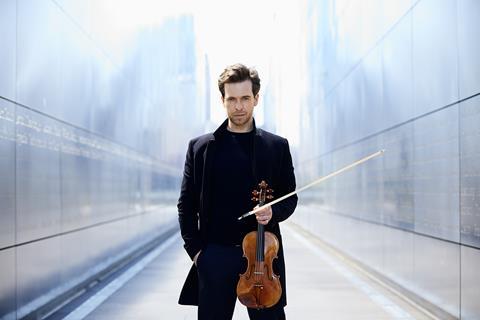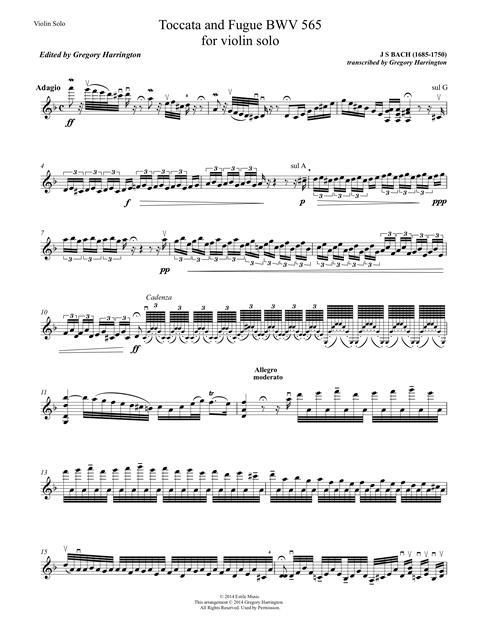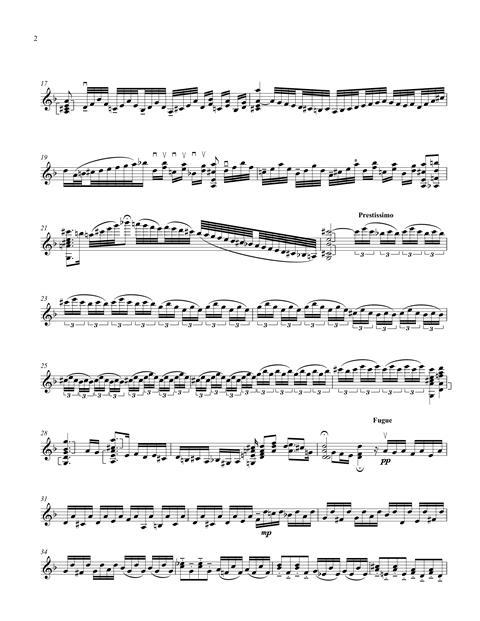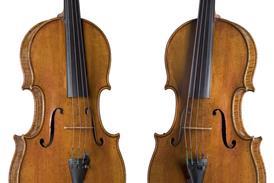Violinist Gregory Harrington shares his process of transcribing Bach’s iconic organ work for solo violin

No matter what stage you happen to be performing on - from the illustrious Carnegie Hall to a beautiful church in the middle of Ireland - everyone can relate to the majestic beauty of J. S. Bach being performed on a solo violin. There is an indelible uniqueness to the effect that his grandiose sound, propelling sense of rhythm and powerful sonorities of his music have on performer and audience member alike. Over the past 15 years, I have been creating transcriptions for the concert stage and always found it so important to juxtapose works by famous composers alongside iconic repertoire from other genres, all reimagined through the lens of a violin.
The Toccata and Fugue in D Minor BWV565 happens to be one of the most recognisable and epic works of Bach. Not only is it one of the great organ works, it has been thrust into the spotlight with cult status due to its appearance in the 1940 Disney classic Fantasia and its subsequent association with horror films. While the Chaconne from the D minor Partita represents the ’Mt. Everest’ for violinists, the Toccata and Fugue in D minor is one of the most famous pieces of Baroque organ music ever written – where its iconic opening represents the pinnacle of the art.
Read: Bach Solo Violin Sonatas: At heart a fugue
Watch: Lech Antonio Uszynski plays Toccata and Fugue on the viola
Begin with the Language
The opportunity to learn and begin that wonderful journey of internalising the language of a new composer is always exciting. With any first encounter, it presents fresh problems and technical riddles to solve. Never more relevant when it comes to the music of Bach when trying to formulate an interpretation of one of his pieces. To come to an interpretative conclusion means understanding his grammar, syntax, vocabulary and what can be expressed within the framework of his music. In essence it is his unique language. It comprises power and complexity mixed with fragility and a thousand different tonal colours available to the interpreter. The main challenge with solo Bach is that the violinist has to become a soloist, a supporting partner, the manager of rhythmic drive and curator of the melodic line all at once. And within that framework, it is about finding that balance of making the interpretation an interesting statement without sounding overly romantic.
The first part of this magnificent piece takes the form of a toccata, which comes from the Italian toccare, meaning ’to touch’. In general terms, the Toccata was created to reveal the virtuosity of the performer’s touch and agility showcasing fast arpeggios and free form runs up and down the instrument. It also allows significant latitude for personal expression while serving as an introduction to the complex fugue which follows. When performing this transcription of this Toccata (and there is speculation that it may have begun life as a violin piece) or any other work of Bach for that matter, one should always start with the architecture and chord structure as the underlying basis of what is possible and how to form your interpretation. In the Toccata, the opening three measures almost mimic the improvisatory character of the opening phrase of the Adagio from the Solo Sonata no.1 in G minor where cathedral-like chords hold the foundation and the improvisatory parts ebb and flow until they re-emerge at the cadence. Immediately following, there is an opportunity to explore the dreamy and whisper like sonorities with tonal shades on the A string in bars four through ten balancing out the opening phrase with beautiful pianissimos. As we progress through a small cadenza and some virtuoso runs, keep the greater structure in mind when formulating your interpretation. From bar 27 to the final cadence of the Toccata at bar 31, you can channel a more organ-like sound on the violin by breaking and voicing the five-part chords (similar to how Ysaÿe did in his solo sonatas) to give the illusion of a more booming and fuller harmonic sound and presence.


Blending voices
When it comes to learning the music of Bach, the idea of blending voices is paramount for any successful interpretation. When creating the transcription, the first step I took was to look at the original organ score and conceptualise how it should organically sound on a violin. I wanted to hear how each tone and distinct voice could find its perfect positioning. As the Baroque violin fingerboard was shorter than our current modern fingerboard and didn’t extend past third position, I wanted to adapt to current specifications and create a transcription that not only spanned across the instrument’s evolution but also across time periods.
The structure of any fugue normally begins with single notes that become two and then three notes. Eventually that can lead to four-note chords. Analyse the size of the chord and the progression of increasing chord sizes and that gives you an idea of how to map the tension and resolve, thus creating a natural crescendo that grows until its cadence. When performing polyphonic music on a violin, the fugue should not sound like there is just one violin performing but that it is a combination of 2 or 3 simultaneous violins playing at any one time. Therefore, there are different weights on each note of a two, three or four-part chord in order to bring out the required melodic theme. That is also why chords can be played from the bottom note upwards when the theme is in the soprano voice or conversely from the top note down when the theme enters in the bass voice. Here the chords must be attacked from the top (which is rare and rather difficult at first) in order to bring out the bassline. The final cadence of the Toccata in bar 30 is one example of landing on the inner voice. Another excellent example of this is bar 39 of the A minor sonata fugue.
Importance of the bow and vibrato
One of the difficulties in performing Bach is that his music needs a very special approach in how it is played. On one side, the interpretation cannot be too romantic but on the other side there are many musicians that play Bach in a way that is too sterile. Finding that delicate balance is so important! That is not to say that there are moments where an ethereal colour can be appropriate and give variety, but as a general concept the musical interpretation has to have soul. After all, Bach was most definitely a passionate composer!
One of the easiest ways examine and formulate your own interpretational ideas are to explore in detail two fundamental techniques - the use of vibrato and the function of the bow. Too much vibrato will take away from your core message and distract the audience from the moment you are creating. But it is also important to use some vibrato as without it, you will get that sterile sound. So, your overall goal is to use vibrato as a colour so that the music has transparency by finding the balance between musically interesting and not too romantic.
When it comes to bowing technique, we have to take into consideration the difference the modern bow makes to our sound canvas. With a modern instrument you are trying to draw on the mechanics and effect of what a baroque bow does with a gut string. Slower notes and longer phrases had an intensity due to the manner of the slow bow speed sinking into the gut. Fast notes can come alive and sparkle when recreating that gutsy sound of the bow on the string. Experiment with different bow pressures and speeds on different passages and let your ear be the judge. For a separate study, the Italian composer Geminiani talks about the ten types of vibrato and their interpretational usage ranging from emoting love to anger. He also makes interesting observations about how to hold the bow and an implied bow grip above the nut.
In this transcription, there are two main distinct types of bowing to master. The first is legato and the second is detaché (amidst a sprinkling of spiccato and ricochet). When making the reference to language, I always like to think that legato represents the vowel in speech and detaché represents the consonant. This is a mindset that we should never lose sight of or underestimate its importance because you are always speaking with your bow. If you take the opening fugal statement in bars 30 and 31 and the following iterations throughout the piece, you can create the subtlest difference in the upper and lower register by leaning a little heavier in your detaché stroke and adding a little separation once the lower octave A comes into play. This brings out the bass line and contrasting voice. With the running and jumping semiquavers (16th notes) through the rest of the fugue, you need a clear clean sound without it being too thick.
Balancing it out
In bringing it all together to create a balanced interpretation and learning the language of Bach, start by figuring out the harmonic goal and structure of this or any of his pieces. Where there is dissonance, is there a consonant, is there a resolve or is there a release that follows the dissonance? When we don’t have dynamics, let the moments of tension and resolve form the musical shape of the line. And that gives us the possibilities of how to create a very personal and unique interpretation. Remember that it is not always about even bowings and even bow speed but about bringing depth and perception and awareness to the harmonic pattern. And most importantly, you have to make it personal. There’s a sense of drama and resolve in all music of Bach. Become a better student of the harmonic structure and where it resolves and that will lead to better interpretations.
Conclusion
I would encourage you to challenge your technique when finding your own individual voice in how to play Bach. And it is not the necessarily the more modern technique of Perlman, Milstein, Heifetz or Grumiaux. The most organic you thing you can do is approach Bach from underneath, with the context where you understand the structure in the language and then imply your own individuality to your performance which in turn lends authenticity. I am indebted to my first violin teacher Kevin Kiely for showing me how practising Bach had a cathartic dimension to violin playing and analysing it had a true cleansing effect on technique and refocusing your ear.
And remember, take comfort in the fact that there is no ceiling to perfection. Your performance will never be unanimously loved by all. Be authentic and true to yourself. Deliver something tremendously organic to your audience and you can’t go wrong!
Gregory Harrington is an Irish violinist based in New York City and is a concert soloist, teacher and speaker/coach for the corporate industry. Sign up on his website gregoryharrington.com and download his new album Glass Hour on Bandcamp. To continue the conversation feel free to contact him at greg@gregoryharrington.com or follow him on Instagram @harringtonviolin
Link to buy the score: https://www.sheetmusicplus.com/title/toccata-and-fugue-for-solo-violin-bwv-565-in-d-minor-digital-sheet-music/21814105


































No comments yet